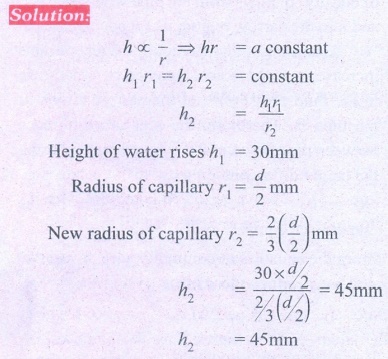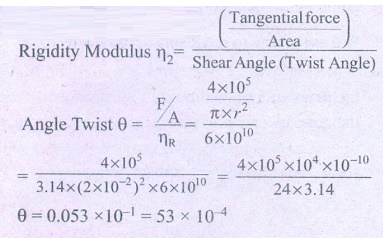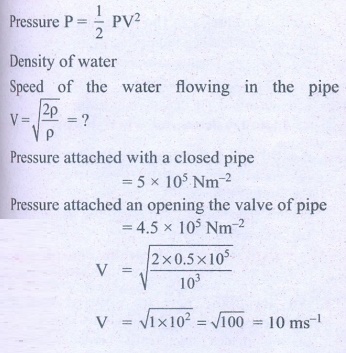Physics - Properties of Matter: Important Questions | 11th Physics : UNIT 7 : Properties of Matter
Chapter: 11th Physics : UNIT 7 : Properties of Matter
Properties of Matter: Important Questions
Short Answer Questions
1. Define stress and
strain.
2. State HookeŌĆÖs law of
elasticity.
3. Define PoissonŌĆÖs
ratio.
4. Explain elasticity using
intermolecular forces.
5. Which one of these
is more elastic, steel or rubber? Why?
6. A spring balance
shows wrong readings after using for a long time. Why?
7. What is the effect
of temperature on elasticity?
8. Write down the
expression for the elastic potential energy of a stretched wire.
9. State PascalŌĆÖs law
in fluids.
10. State Archimedes
principle.
11. What do you mean by
upthrust or buoyancy?
12. State the law of
floatation.
13. Define coefficient
of viscosity of a liquid.
14. Distinguish between
streamlined flow and turbulent flow.
15. What is ReynoldŌĆÖs
number? Give its significance.
16. Define terminal
velocity.
17. Write down the
expression for the StokeŌĆÖs force and explain the symbols involved in it.
18. State BernoulliŌĆÖs
theorem.
19. What are the
energies possessed by a liquid? Write down their equations.
20. Two streamlines
cannot cross each other. Why?
21. Define surface
tension of a liquid. Mention its S.I unit and dimension.
22. How is surface tension
related to surface energy?
23. Define angle of
contact for a given pair of solid and liquid.
24. Distinguish between
cohesive and adhesive forces.
25. What are the
factors affecting the surface tension of a liquid?
26. What happens to the
pressure inside a soap bubble when air is blown into it?
27. What do you mean by
capillarity or capillary action?
28. A drop of oil
placed on the surface of water spreads out. But a drop of water place on oil
contracts to a spherical shape. Why?
29. State the principle
and usage of Venturimeter.
Long Answer Questions
1. State HookeŌĆÖs law
and verify it with the help of an experiment.
2. Explain the
different types of modulus of elasticity.
3. Derive an expression
for the elastic energy stored per unit volume of a wire.
4. Derive an equation
for the total pressure at a depth ŌĆśhŌĆÖ below the liquid surface.
5. State and prove
PascalŌĆÖs law in fluids.
6. State and prove
Archimedes principle.
7. Derive the
expression for the terminal velocity of a sphere moving in a high viscous fluid
using stokes force.
8. Derive PoiseuilleŌĆÖs
formula for the volume of a liquid flowing per second through a pipe under
streamlined flow.
9. Obtain an expression
for the excess of pressure inside a i) liquid drop
ii) liquid bubble iii)
air bubble.
10. What is
capillarity? Obtain an expression for the surface tension of a liquid by
capillary rise method.
11. Obtain an equation
of continuity for a flow of fluid on the basis of conservation of mass.
12. State and prove
BernoulliŌĆÖs theorem for a flow of incompressible, non-viscous, and streamlined
flow of fluid.
13. Describe the
construction and working of venturimeter and obtain an equation for the volume
of liquid flowing per second through a wider entry of the tube.
Numerical Problems
1. A capillary of diameter dmm is dipped in water such that the water rises to a height of 30mm. If the radius of the capillary is made (2/3) of its previous value, then compute the height up to which water will rise in the new capillary?

(Answer: 45 mm)
2. A cylinder of length 1.5ŌĆåm and diameter 4 cm is fixed at one end. A tangential force of 4 ├Ś 105 N is applied at the other end. If the rigidity modulus of the cylinder is 6 ├Ś 1010 NŌĆåm-2 then, calculate the twist produced in the cylinder.
Solution:
Length of a cylinder = 1.5 m
Diameter = 4 cm; Tangential force F - 4 ├Ś 105N
Rigidity modulus ╬Ę = 6 ├Ś 1010 Nm-2
Twist produced ╬Ė = ?

╬Ė = 0.053 ├Ś 10-1 = 53 ├Ś 10-4
(Answer: 45.60)
3. A spherical soap bubble A of radius 2 cm is formed inside another bubble B of radius 4 cm. Show that the radius of a single soap bubble which maintains the same pressure difference as inside the smaller and outside the larger soap bubble is lesser than radius of both soap bubbles A and B.
Solution
Excess pressure create with S.T of spherical surface of the liquid = ΔP = 2T/R
T - surface tension
In case of soap bubbles,
The excess pressure of air inside them is double due to the presence of two interfaces are inside and one outside.

Excess pressure of air inside the bigger bubble

Excess pressure of air inside the smaller bubble 4s 4T

Air pressure difference between the smaller bubble and the atmosphere will be equal toll sum of excess pressure inside the bigger smaller bubbles.
Pressure different ΔP = ΔPb + ΔPs
= T + 2T = 3T
Excess pressure inside a single soap bubble = 4T/R = 4T/4 = T
Pressure difference of single soap bubble less than radius of both T < 3T
4. A block of Ag of mass x kg hanging from a string is immersed in a liquid of relative density 0.72. If the relative density of Ag is 10 and tension in the string is 37.12 N then compute the mass of Ag block.
Soltion
Relative density of liquid Žüliquid = 0.72
Relative density of Ag ŽüAg = 10
Mass of the Ag block = ?
Tension in the string T = 37.12 N
Apparent weight Wapp = pAg - pliquid
= 10-0.72 = 9.28
m = TAg / g
m = 37.12 / 9.28 = 4
Mass x = 4 kg
(Answer: x = 4 kg)
5. The reading of pressure meter attached with a closed pipe is 5 ├Ś 105 NŌĆåm-2. On opening the valve of the pipe, the reading of the pressure meter is 4.5 ├Ś 105 Nm-2. Calculate the speed of the water flowing in the pipe.
Solution

(Answer: 10 ms-1)
Conceptual questions
1. Why coffee runs up into a sugar lump (a small cube of sugar) when one corner of the sugar lump is held in the liquid?
Answer:
(i) If sugar cube is dropped into liquid the outermost layer has to dissolve first, then next layer, then next until the whole sugar is dissolved.
(ii) The coffee runs up into the pores of sugar lump due to capillary action of the liquid.
2. Why two holes are made to empty an oil tin?
Answer:
When oil comes out from a hole of an oil tin, pressure inside it decreased than the atmosphere. Therefore, the surrounding air rush up into the same hole prevents the oil to come out. Hence two holes are made to empty the oil tin.
3. We can cut vegetables easily with a sharp knife as compared to a blunt knife. Why?
Answer:
Since the stress produced on the vegetables by the sharp knife is higher than the blunt knife, vegetables can be cut easily with the sharp knife.
4. Why the passengers are advised to remove the ink from their pens while going up in an aeroplane?
Answer:
When an aero-plane ascends, the atmospheric pressure is decreased. Hence, the ink from the pen will leak out. So that, the passengers are advised to remove the ink from their pens while going up in the aero-plane.
5. We use straw to suck soft drinks, why?
Answer:
When we suck the soft drinks through the straw, the pressure inside the straw becomes less than the atmospheric pressure. Due to the difference in pressure, the soft drink rises in the straw and we are able to enjoy it conveniently.
Related Topics